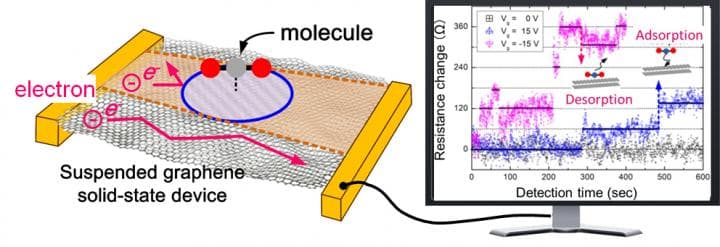Scientists Develop An Economical, Compact Graphene Based Sensor For Detecting Air Pollution
The wonder material Graphene is again in the news. This time, a group of scientists from the University of Southampton has collaborated with the Japan Advanced Institute of Science and Technology (JAIST), to create an artificial sense and switch system that can detect small air-polluting ingredients at home, in exchange of very low power consumption. The system can automatically detect individual CO2 molecules and volatile organic compounds that stick to enclosed volumetric materials in the house hold surface as well as air.
These small particles possess an extreme narrow concentration in ppb (parts per billion levels) which go undetected when passed through any existing room cleaner technology, programmed to work at the ppm level. The group moved to this project to cure the sick building syndrome (SBS), and other similar sicknesses. Team leader Hiroshi Mizuta, a joint appointee at the University of Southampton and JAIST and his colleagues engineered a sensor based on the charge transfer mechanism to detect each CO2 molecule, adsorbed on the suspended Graphene, a honey comb shaped Carbon allotrope.

A diagram of the complete system
The amount of electrical resistance in the Graphene roll here, signifies proportionally the number of adsorbed and desorbed CO2 molecules and is counted as “Quantised†charges in resistance. Professor Mizuta explained that, in comparison to conventional environment monitoring tools, the newest research product is small and cost effective. Moreover, the complete system has now shifted to a whole new level from, ppm to ppb.
The same research group has also recently developed a graphene based switch based on a special type of thin film. The group currently started working to combine these two research works in order to develop an ultra-low-power environmental sensor systems for detecting single molecular pollutants. The current research report was published in the journal, “Science Advancesâ€.
Sources: #-Link-Snipped-#
These small particles possess an extreme narrow concentration in ppb (parts per billion levels) which go undetected when passed through any existing room cleaner technology, programmed to work at the ppm level. The group moved to this project to cure the sick building syndrome (SBS), and other similar sicknesses. Team leader Hiroshi Mizuta, a joint appointee at the University of Southampton and JAIST and his colleagues engineered a sensor based on the charge transfer mechanism to detect each CO2 molecule, adsorbed on the suspended Graphene, a honey comb shaped Carbon allotrope.

A diagram of the complete system
The amount of electrical resistance in the Graphene roll here, signifies proportionally the number of adsorbed and desorbed CO2 molecules and is counted as “Quantised†charges in resistance. Professor Mizuta explained that, in comparison to conventional environment monitoring tools, the newest research product is small and cost effective. Moreover, the complete system has now shifted to a whole new level from, ppm to ppb.
The same research group has also recently developed a graphene based switch based on a special type of thin film. The group currently started working to combine these two research works in order to develop an ultra-low-power environmental sensor systems for detecting single molecular pollutants. The current research report was published in the journal, “Science Advancesâ€.
Sources: #-Link-Snipped-#
0
